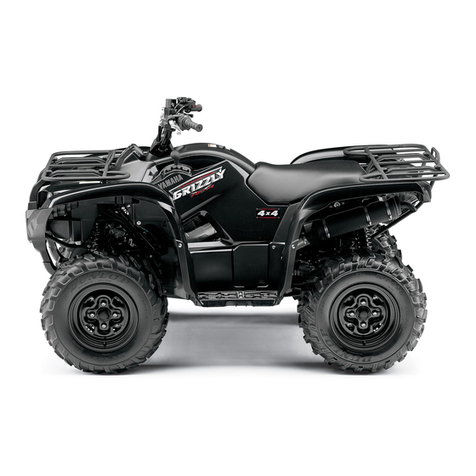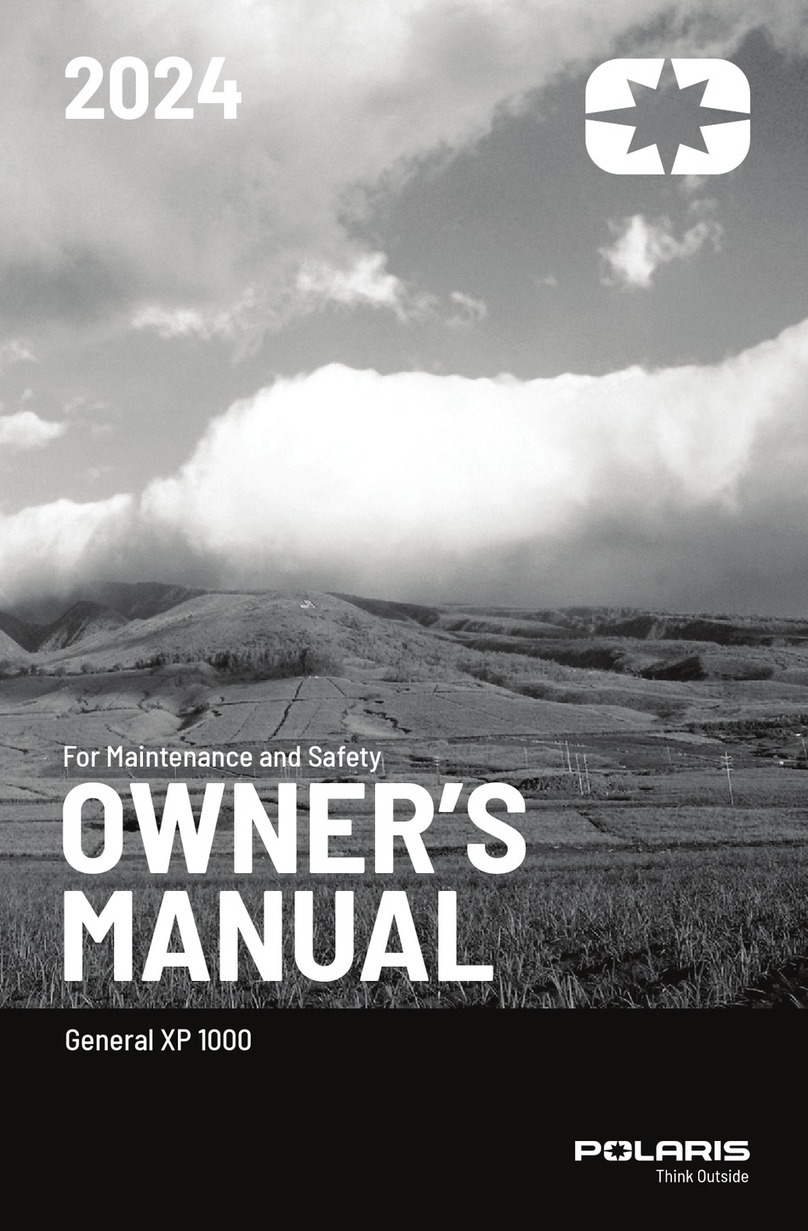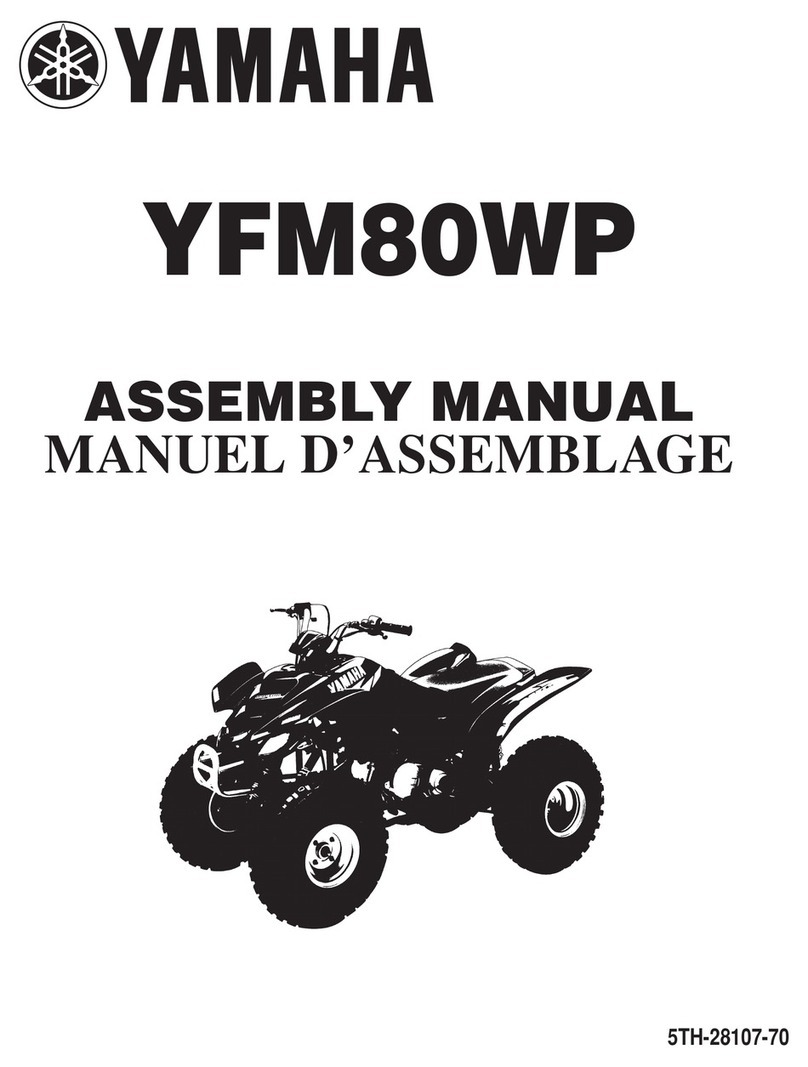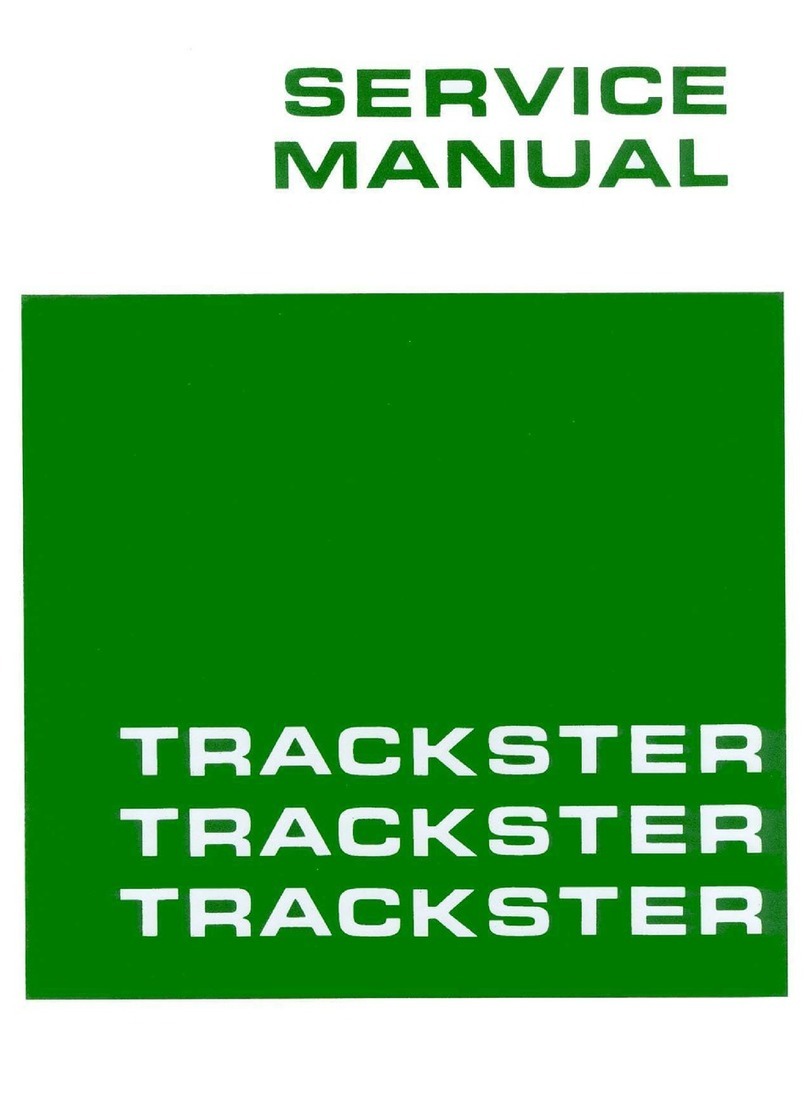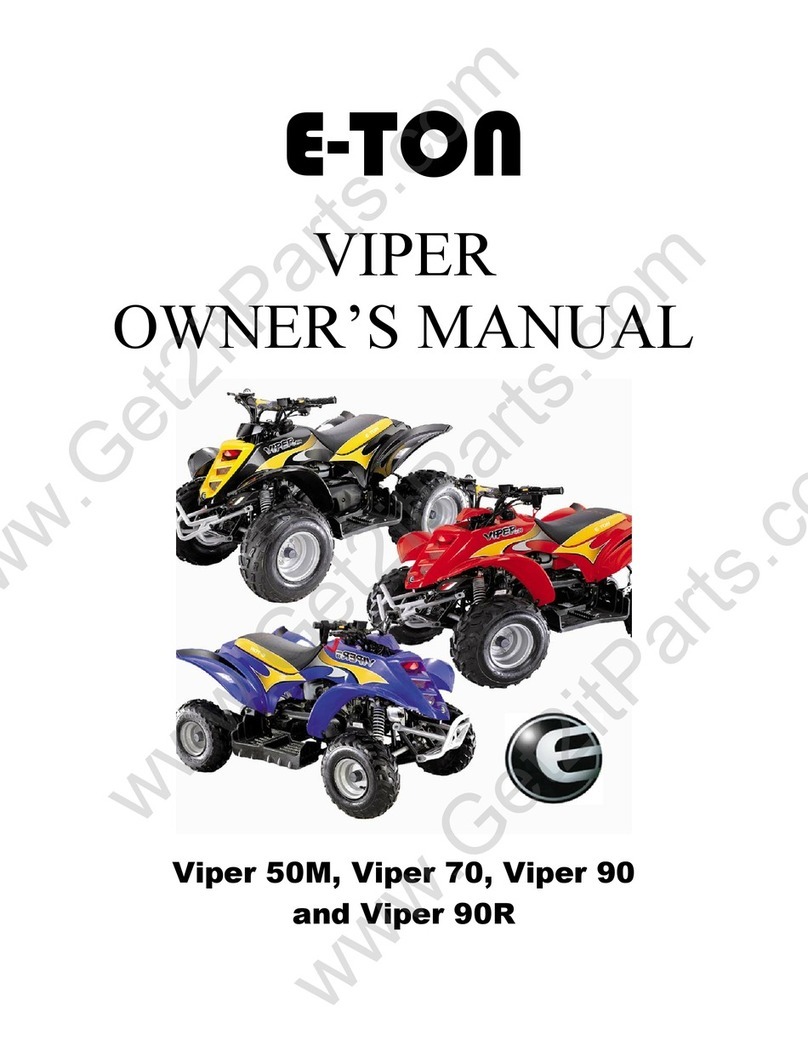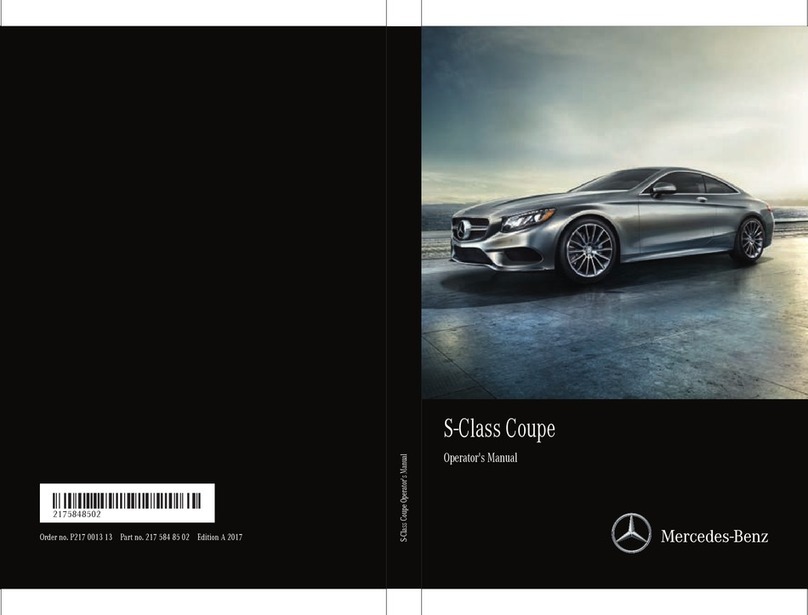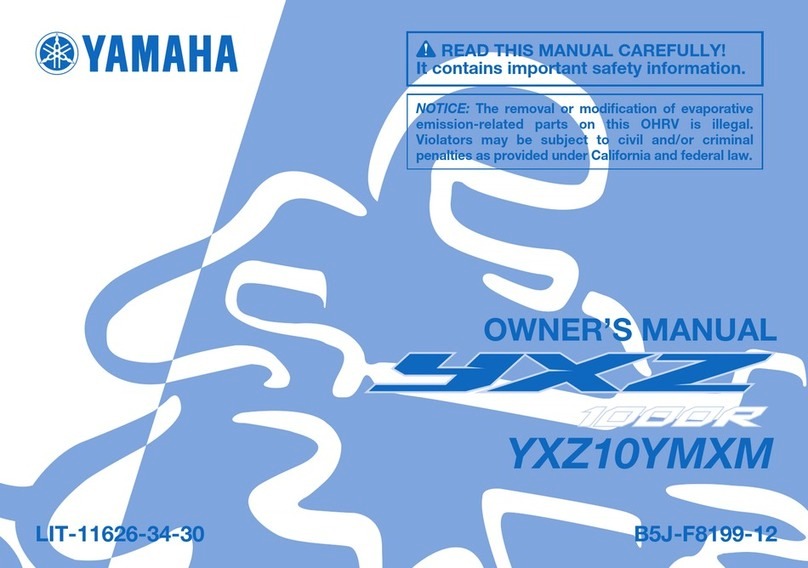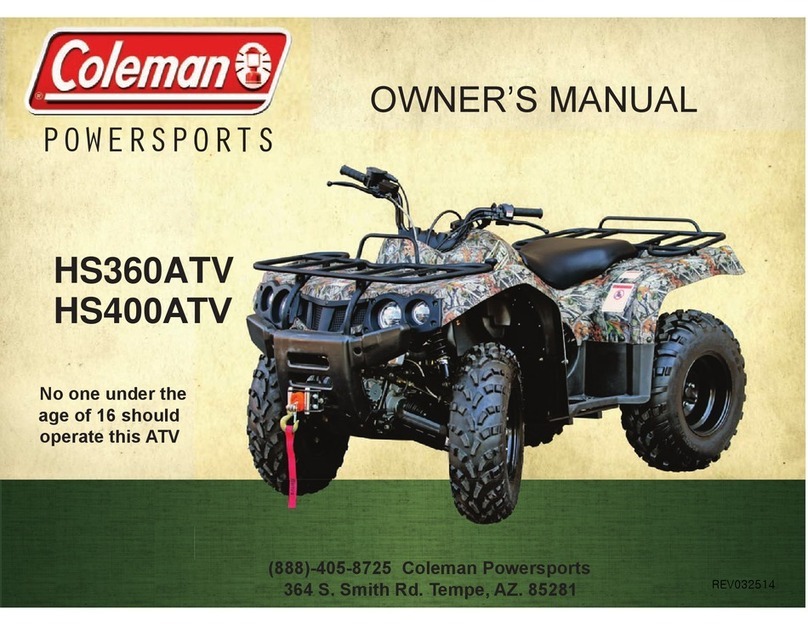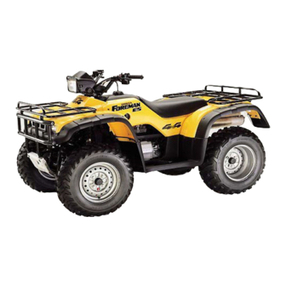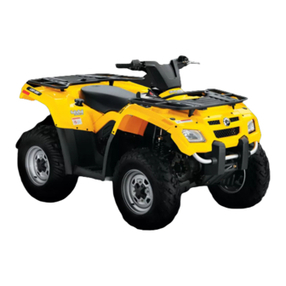Blizzard 1980 Bombardier 5500 ski-doo User manual

Litho'd in
Canada
1980
OPERATOR'S
MANUAL

model
V.I.N.
purchase
date _
warranty
expiry
date
DEALER IMPRINT AREA
MOTO~SKI
FUTURA
SPIRIT
NUVIK
MIRAGE
SUPER SONIC
ULTRA SONIC
Text by:
TECHNICAL INFORMATION CENTRE
AFTER SALES SERVICE DEPARTMENT
BOMBARDIER LIMITED
VALCOURT, QUEBEC
CANADA, JOE2LO
The following are trademarks of Bom-
bardier Limited.
BOMBARDIER EVEREST
SKI~DOO
CITATION
ALPINE OLYMPIQUE
BLIZZARD
T'NT
CARRY-BOOSE
ELAN
ELITE
GRAND PRIX SPECIAL

INDEX
FOREWORD 2
SAFETY IN MAINTENANCE 3
CONTROUINSTRUMENTS
Throttle lever, brake lever, ignition/light switch, headlamp dimmer switch,
emergency cut-out switch, manual starter handle, primer, speedometer, tether
cut-out switch, cab opening, tool box, fuel gauge 5
BREAK-IN PERIOD
Break-in, inspection, inspection checklist . 8
FUEL
MIXING
Recommended gasoline, recommended oil, fuel mixture ratio, fuel mixing pro-
cedure . . . . . . . . . . . . . . . . . . . . . . . . . . . . . . . . . . . . . . . . . . 8
PRE-START CHECK
Check points 9
STARTING PROCEpuRE
Starting procedure, emergency
starting.
. . . . . . . . . . . . . . . . . .
..
. 10
LUBRICATION
Frequency, belt guard removal, drive belt removal, steering mechanism, chain-
caseoiIlevel
.,
11
MAINTENANCE
Maintenance chart, spark plug, suspension, track, track tension and alignment,
carburetor adjustment, drive belt, steering mechanism, drive pulley, brake, steer-
ing adjustment, engine head nuts, engine mount nuts, muffler attachment, fan
belt, general inspection, headlamp beam aiming, bulb replacement 12
STORAGE
Track, suspension, ski assembly, controls, chaincase, fuel tank, carburetors,
cylinder lubrication, chassis, general inspection. . . . . .
.. ..
. 18
PRE-SEASON PREPARATION
Pre-seasonpreparation, chart, . .21
TROUBLESHOOTING . . . ..
..
... 22
TOOLS 24
SPECIFICATIONS 25
WIRING
DIAGRAM
28
S.I. METRICINFORMATION GUIDE 27
THE 1980uLIMITED WARRANTY" . 28
OFTEN ASKED QUESTIONS
~
CONSUMER GUIDE ,34
LISTING OFAREA DISTRIBUTORS. . . . . . . .. . . . . . . . .. . . . .
..
.35
HOW
TO
IDENTIFY
YOUR
SNOWMOBILE
38
CHANGEOF ADDRESS OR OWNERSHIP 37

FOREWORD
CONGRATULATIONS ... You are now
the proud owner of a new 1980 Bom-
bardier snowmobile. This vehicle is the
result of incomparable teamwork be-
tween Bombardier designers, engi-
neers and technicians. Consequently,
this vehicle is designed and engineered
with safety, handling, comfort and
quietness in mind.
The
Operator
Manual
and
the Snow-
mobile Safety handbook have been
prepared
to
acquaint
theowner/
oper-
ator of a new snowmobile with the var-
ious vehicle controls maintenance and
safe operating instructions.
Each is indispensable for the proper
use of the product, and should be kept
with the vehicle at all times.
Should you have any questions per-
taining to the warranty and its applica-
tion, please consult the "Often Asked
Question" section of this manual, or
your selling dealer.
This manual emphasizes particular in-
formation denoted by the following
symbols and wording.
...
WARNING:
Identifies
an
instruc-
~
tion
which,
if not
followed,
could
cause
personal
injury.
...
CAUTION:
Denotes
an
instruc-
.".
tionwhich,if notfollowed,
could
severely
damage
vehicle
components.
O
NOTE:
Indicates supplementary
information needed to fully com-
plete an instruction.
Although the mere reading of such in-
formation does not eliminate the haz-
ard, your understanding of the infor-
mation will promote its correct use.
Ride safe and have fun.
Recreational Products Group
Bombardier Limited,
Valcourt, Quebec, Canada,
JOE
2LO
PLEASE ENSUREYOUR WARRANTY BY REGISTERINGYOUR
SNOWMOBILE THROUGH YOUR DEALER, AT THE COM-
PANY.
2

SAFETY IN
MAINTENANCE
Observe the following
precautions:
•Throttle mechanism should be
checked for free movement before
starting engine.
• Engineshould be running only when
pulley guard is secured in place.
• Never run engine without drive belt
installed. Running an unloaded en-
qine can prove to be dangerous.
• Never run engine when the track of
the vehicle is raised
off
the ground.
• It can be dangerous to run engine
with the cab removed.
• Gasolineis flammable and explosive
under certain conditions. Always
perform procedures in awell ventila-
ted area. Do not smoke or allow
open flames or sparksin the vicinity.
If gasoline fumes are noticed while
driving, the cause should be deter-
mined and corrected without delay.
• Your snowmobile is not designed to
be operated on public streets, road
or highways. In most States and
Provinces, it is considered an illegal
operation.
• Maintain your vehicle in top mecha-
nical condition at all times.
• Your snowmobile is not designed to
be driven or operated on black top,
bare earth, or other abrasive sur-
faces. On such surfaces abnormal
and excessive wear of critical parts
is inevitable.
• Only perform procedures asdetailed
in this manual. Unless otherwise
specified, engine should be turned
OFF for all lubrication and mainte-
nance procedures.
• Installation of other than standard
equipment, including ski-spreaders,
bumpers, pack racks, etc., could
severelyaffect the stability and safe-
ty of your vehicle. Avoid adding on
accessories that alter the basic ve-
hicle configuration.
• The snowmobile engine can be
stopped by activating the emergen-
cy cut-out switch, tether switch or
byturning off the key.
• This vehicle is designed for the
driver only. No provisions havebeen
made for a passenger.
• Whenever the vehicle is parked out-
doors, overnight or for a long
period, it is suggested to protect it
against the inclemency of the
wheather with a snowmobile cover.
Please read and understand all other
warnings contained elsewhere.
THIS
MANUAL
SHOULD REMAIN WITH THE VEHICLE AT
THE TIME OF
RESALE.
3

CONTROLS/INSTRUMENTS
B
c
«5)
o~
e
r
(Q>
(Q>
.
J/~f
EA
-w---t---F
lrJollll-lr---tf---
G
A) Throttle Control Lever
BJ
Brake Control Lever
C) Ignition/Light Switch
D) Headlamp Dimmer Switch
EJ
Emergency Cut-Out Switch
A)
Throttle Control Lever
Located on right side of handlebar.
When compressed, it controls the en-
gine speed and the engagement of the
transmission. When released, engine
speed returns automatically to idle.
B) Brake Control Lever
Located on the left side of handlebar.
When compressed, the brake is ap-
plied. When released, it automatically
returns to its original position. Braking
effect is proportionate to the pressure
applied on the lever.
4
F) Manual Starter Handle
GJ
Primer
H) Speedometer
I) Tether Cut-Out Switch
C) Ignition/Light Switch
OFF
".
ON
Key operated, 2 position switch. To
start engine, first turn key clockwise to
ON position. To stop engine, turn key
counter-clockwise to OFF position.
The lights are automatically ON when-
ever the engine is running.

D) Headlamp Dimmer Switch
The dimmer switch, located on left
side of handlebarIallows correct selec-
tion of headlamp beam. To obtain high
or low beam simply depress switch.
E) Emergency Cut-Out Switch
A push button switch located on right
side of handlebar. To stop the engine
in an emergency, press button down
into lower position.
Before re-starting engine always de-
press button into released upper posi-
tion. The driver of this vehicle should
familiarize himself with the function of
this device by using it several times on
first outing. Thereby being mentally
prepared for emergency situations re-
quiring its use.
...
WARNING: If the button has
....
been used in an emergency situa-
tion the source of malfunction should
be determined and corrected before re-
starting engine.
F) Manual Starter Handle
Auto rewind type located on right hand
side of vehicle. To engage mechanism,
pull handle.
G) Primer
A push-pull button. Pull and push but-
ton (2-3 times) to activate primer. The
primer should always be used for cold
engine starts. After engine is warm
however, it is not necessary to use
primer when starting.
H) Speedometer
The speedometer is linked directly to
the drive axle. Direct-reading dial indi-
cates the speed of the vehicle. Odom-
eter records the total number of dis-
tance travelled.
I) Tether Cut-Out Switch
Attach tether cord to wrist or other
convenient location then snap tether
cut-out cap over receptacle before
starting engine.
If emergency engine
"shut-off"
is re-
quired completely pull cap from safety
switch and engine power will be auto-
matically shut
It
off"
.
ONOTE: The cap must be installed
on the safety switch at all times
in order to operate the vehicle.
...
WARNING: If the switch is used
....
in an emergency situation the
source of malfunction should be deter-
mined and corrected before restarting
engine.
Cab Opening
Pull down the latch to unhook the cab
from the anchor.
ONOTE: Always lift cab gently up
until stopped by restraining de-
vice.
...
WARNING: It is dangerous to
....
run an engine
with
the cab open
or removed. Personal injury could
result.
~
CAUTION: Prior to re-securing
Ythe cab latch, position the bot-
tom edge of the cab into the cab guide
located on each side of the frame.
Cab guide
5

ToolBox
Located under the cab. To gainaccess,
tilt cab. Ideal location for spare plugs,
belt, rope, etc.
Fuel Gauge
The fuel gauge is located on the left
side of the fuel tank. The gauge func-
tions on the principle of communicat-
ing vessels, so the fuel level inside the
tank isdirectly related with the level in-
dicated on the gauge.
.A.
WARNING: Never use a lite
,.,
match or open flame to check
fuel level.
6
BREAK-IN PERIOD
With Bombardier-Rotax snowmobile
engines, a break-in period is required
before running the vehicle at full throt-
tle. Engine's manufacturer recommen-
dation is 10to 15operating hours. Dur-
ing this period, a richer mixture is
needed (i.e, 40 parts of gasfor 1part of
50/1 Bombardier oil). Maximum throt-
tle should not exceed
3/4,
however,
brief full acceleration and speed varia-
tions contribute to a good break-in.
Continued wide open throttle accelera-
tions, prolonged cruising speeds, and
lugging are detrimental during the
break-in period.
1D-Hour Inspection
As with any precision pieceof mechan-
ical equipement, we suggest that alter
the first 10 hours of operation or 30
days after the purchase, whichever
comes first, that your vehicle becheck-
ed by your dealer. This inspection will
give you the opportunity to discussthe
unanswered questions you mat have
encountered during the first hours of
operation. Remember that it is easier
to remedy at this time than to allow the
snowmobile to operate until a possible
failure occurs.
The 10 hours inspection is at the ex-
pense of the vehicle owner.

1G-HOUR INSPECTION CHECK LIST J
Engine timing
Fan belt tension
Spark plug condition
Carburetor adjustment
Engine head nuts
Engine mount nuts
Muffler attachment
Chaincaseoil
Jevel
Brake operation and lining condition
Ski alignment (runner condition)
Pulley alignment and drive belt condition
Track condition, tension and alignment
Lubrication (steering)
Electrical wiring (loose connections, stripped wires, damaged insulation), tighten all loose
bolts, nuts and linkage
Operation of lighting system (HI / LO beam, brake light, etc.), test operation of emergency
cut-out switch, tether switch .
We recommend that you have your dealer sign this inspection.
Date of 10 hour inspection Dealer signature
7

FUEL
MIXING
Oil must be added to the gasoline in
pre-measured amounts then both oil
and gasoline should be thoroughly
mixed together before fueling the tank.
Recommended Gasoline
Use regular leaded gasoline available
from all service stations.
_CAUTION: Never experiment
..
with
different fuel or fuel ratios.
Never use naphtha, methanol or similar
products.
Recommended Oil
Use concentrated Bombardier snow-
mobile oil available from your dealer.
This type of oil has specially formu-
lated oil bases to meet the lubrication
requirements of the Bombardier-Rotax
engine.
If Bombardier snowmobile oil is un-
available substitute with ahigh-quality
2 cycle snowmobile oil. The
oil/
gas
mix must meet the vehicle re-
quirements. See oil manufacturer
recommendations on the container.
_CAUTION: Never use outboard
...
or straight mineral oils.
Fuel Mixture Ratio
The importance of using the correct
fuel mixture cannot be overstressed.
An incorrect fuel ratio results in serious
engine damage. Recommended fuel
ratio is 50/1.
(4011
during brake in
period).
S.1. Units
500 mL oil to 25 liters
5011.
Imperial Units
1 can 16
02
oil to 5 Imp. gals =50/1.
or
1 can 500 mL oil to 5
1/2
Imp. gals =
50/1.
U.S. Units
1 can 12
02
oil to 5 U.S. gals 50/1.
ONOTE: To facilitate fuel mixing oil
should be kept at room tempera-
ture.
8
Fuel Mixing Procedure
To mix the gasoline and oil always use
a separate clean container. Never mix
directly in your snowmobile tank. For
best results, acquire
two
containers,
either plastic or metal. Draw from one
until empty then use the second one.
..
WARNING: Gasoline is flamma-
~
ble and explosive under certain
conditions.
Always
perform
pro-
cedures in a well ventilated area. Do
not
smoke or allow open flames or
sparks in the vicinity. If gasoline fumes
are noticed while driving, the cause
should be determined and corrected
without
delay. Never add fuel while the
engine is running. Avoid skin contact
with
fuel at below freezing tempera-
ture.
1. Pour approximately one gallon of
gasoline into a clean container.
2. Add the full amount of oil.

3. Replace the container cap and
shake the container thoroughly.
4.
Add the remainder of the gasoline.
6. Once again thoroughly agitate the
container. Then using a funnel
with
a fine mesh screen to prevent the
entry of water and foreign particles,
pour the mixture into the snow-
mobile tank.
A
WARNING:
To prevent fuel spill-
....
age in the engine compartment, a
funnel must always be used when fill-
ing the gas tank.
aNOTE: When using pre-mixed
fuel, always shake the container
thoroughly as the oil has a tendency to
settle.
A
WARNING:
Never 'top up' the
....
gas tank before placing vehicle
in a warm area. At certain tempera-
tures, gasoline will expand and
overflow. Always wipe off any gasoline
spillagefrom the snowmobile.
PRE-START CHECK
Check Points
•Activate the throttle control lever
several times to check that it oper-
ates easily and smoothly. The throt-
tle control lever must return to idle
position when released.
• Check fuel level.
• Check that the skis and the track are
not
frozen to the grou nd or snow
surface and that the steering oper-
ates freely.
•Activate the brake control lever and
make sure the brake fully applies be-
fore the brake control lever touches
the handlebar grip.
•Verify that the path ahead of the ve-
hicle is clear of bystanders and ob-
stacles.
A
WARNING:
Only startyoursnow-
....
mobile once all components are
checked and functioning properly.
9

STARTING
PROCEDURE
Emergency Cut-Out Button
Manual Stalting
1. Insert the key in the ignition and
turn to ON position.
2. Test the throttle control lever.
3. Activate the primer (2 to 3 times).
ONOTE: Primer is not necessary
when the engine is warm.
4. Ensure the tether cut-out cap is in
position and that the cord is attach-
ed to your clothing. Check that the
emergency cut-out button is in the
release
upper position.
5. Grasp manual starter handle firmly
and pull slowly until a resistance is
felt then pull vigorously. Slowly re-
lease
the rewind starter handle.
+WARNING: Do not apply throttle
while starting.
6. Check operation of the emergency
cut-out switch, and the tether
switch. Restart the engine.
+WARNING: If engine does not
shut-off when applying the emer-
gency cut-outswitch
and/or
by
pulling
the tether cut-out cap, stop the engine
by turning
off
the ignition key. Do not
operate the vehicle further, see your
dealer.
7. Allow the engine to warm before
operating at full throttle.
Upper position
before starting
engine.
Lower position
to stop engine. Emergency Starting
Should the rewind starter rope fray and
break, the engine can be started with
an emergency starter rope.
+WARNING: Do not start the vehi-
cle by the drive pulley unless it is
a true emergency situation, have the
vehicle repaired as soon as possible.
Remove the pulley guard from the
vehicle and wind the emergency rope
tight around the drive pulley between
the sliding half and the roller guard.
Start the engine as per usual manual
starting.
+WARNING: When starting the
vehicle in an emergency situation
by the drive pulley, do not makea knot
at the end of the emergency rope and
do not reinstall the pulley guard.
1~-~'~
Sliding I\ "
half
10

LUBRICATION
3. Slip the belt over the top edge of the
sliding half.
4. Slip the belt out from the drive pul-
ley and remove completely from the
vehicle. To install the drive belt,
reverse the procedure.
Drive Belt Removal
...
WARNING: Never start or run
....
engine
without
the drive belt in-
stalled. Running an unloaded engine is
dangerous.
1. Tilt the cab and remove the belt
guard.
2. Open the driven pulley by twisting
and pushing the sliding half. Hold in
fully open position.
Belt Guard Removal
...
WARNING: Engine should be
....
running only when belt guard is
secured in place.
1. Tilt the cab/ remove both belt guard
retaining clips (A).
2.
Pullout
both B & C retaining pins.
...
WARNING:
At
the removal or in-
....
stallation of the belt guard
front
retaining pin be careful
not
to burn
yourself on the exhaust system.
3. Lift and remove the belt guard
assembly.
Frequency
Routine maintenance is necessary for
all mechanized products, and the
snowmobile is no exception. A weekly
vehicle inspection contributes to the
life span of the snowmobile as well as
retains safe and dependable operation.
It is recommended that the steering
system and suspension be lubricated
monthly or every 40 hours of opera-
tion. If the vehicle is operated in wet
snow or in severe conditions these
items should be lubricated more fre-
quently .
...
WARNING: Only perform such
....
procedures as detailed in this
manual. It is recommended that dealer
assistance be periodically obtained on
other components/systems
not
cov-
ered in this manual. Unless otherwise
specified, engine should be turned OFF
for all lubrication and maintenance pro-
cedures.
11

MAINTENANCE
Fillro\J-J
0
plug o
/
Chaincase Oil Level
Check the oil level by removing the oil
level cap plug.
Steering Mechanism
....
WARNING: Do
not
lubricate
.",.
throttle
and/or
brake cables and
housings.
Lubricate the ski legs at grease fittings
until new grease appears at joints. Oil
spring coupler bolts.
Code (Weekly) Page
W1
Spark plug 12
W2 Suspension condition 13
W3 Track condition 13
W4 Track tension and alignment 13
W5 Carburetor adjustment 14
W6 Drive belt 15
W7 Steering mechanism 15
W8 Drive pulley 16
Code (Monthly) Page
Ml
Brake 16
M2 Steering adjustment 16
M3 Engine head nuts 17
M4 Engine mount nuts 17
M5 Muffler attachment 17
M6 Fan belt 17
M7 General inspection 17
Headlamp adjustment
The following Maintenance Chart indi-
cates regular servicing schedules to be
performed by you or your servicing
dealer. If these services are performed
as suggested, your snowmobile will
give you many years of low-cost use.
....
WARNING: Only perform such
.",.
procedures as detailed in this
manual. It is recommended that dealer
assistance be periodically obtained on
other components/systems
not
cov-
ered in this manual. Unless otherwise
specified, engine should be turned OFF
for
all lubrication and maintenance pro-
cedures.
Oil level
The oil should be level with the bottom
of the oil level orifice.
ONOTE: The chaincase oil capacity
is approximately 170 mL (6 oz.l.
(W1) Spark Plugs
Disconnect the spark plug wires and
remove the spark plugs.
Check the condition of the plugs.
.• A brownish tip reflects ideal condi-
tions. (Correct carburetor, spark
plug heat range; etc.).
• A black insulator tip indicates fouling
caused by: carburetor idle speed
mixture
and/or
high speed mixture
too rich, incorrect fuel mixture ratio,
wrong type of spark plug (heat
range), or excessive idling.
12

• A light grey insulator tip indicates a
lean mixture caused by; carburetor
high speed mixture adjusted too
lean, wrong spark plug heat range,
incorrect fuel mixture ratio, or a
leaking seal or gasket.
Overheated
(light grey)Normal (brownish)
~
CAUTION: If spark plug condi-
..
tion is not ideal, contact your au-
thorized dealer.
Check spark plug gap using a wire
feeler gauge.
Reinstall plugs and connect wires.
(W2) Suspension Condition
Visually inspect all suspension compo-
nents including slider shoes, springs,
wheels, etc...
ONOTE: During normal driving,
snow will act as a lubricant and
coolant for the slider shoes. Extensive
riding on ice or sanded snow, (not to
mention dirt, asphalt, etc. never re-
commended) will create excessive heat
build-up and cause premature slider
shoe wear.
(W3) Track Condition
Lift the rear of the vehicle and support
it
off
the ground. With the engine off,
rotate the track by hand, and inspect
condition. If worn, cut or track fibers
are exposed or missing or defective in-
serts or guides are noted, contact your
dealer.
...
WARNING: Do not operate a
..
snowmobile with a cut, torn or
damaged track.
(W4) Track Tension and
Alignment
The suspension is adjustable, the front
adjustment for surface condition, the
rear for driver's weight.
When the front adjuster blocks are at
the lowest elevation more weight is
distributed on the skis. At the highest
position the weight is transferred to the
track. The rear adjuster blocks should
be adjusted to suit the driver's
preference.
Adjuster blocks
~
CAUTION: Always turn the left
..
side adjuster blocks in a clock-
wise direction, the rightsideblocksina
counter-clockwise direction. Left and
right adjuster blocks of each adjust-
ment must always be set at the same
elevation.
Lift the rearof vehicle and support with
a mechanical stand.
Allow
the slide to
extend normally. Check the gap 13mm
(1/2")
between the slider shoe and the
bottom inside of the track. If the track
tension is too loose, the track will have
atendency to thump.
_CAUTION: Too much tension
..
will result in power loss and ex-
cessive
stresses
on suspension com-
ponents.
13

If necessary to adjust, loosen the rear
idler wheel retaining screw and then
loosen or tighten the adjuster bolts lo-
cated on the inner side of the rear idler
wheels. If correct tension is unat-
tainable. Contact your dealer.
ONOTE: Track tension and align-
ment are inter-related. Do not ad-
just one
without
the other.
Start the engine and accelerate slightly
so that the track turns slowly. Check
that the track is well centered; equal
distance on both sides between edges
of track guides and slider shoes.
...
WARNING:
Before checking
",.
track alignment, ensure that the
track is free of all particles which could
be thrown
out
while track is rotating.
Keep hands, tools, feet and clothing
clear of track. Ensure no-one is stand-
ing in close proximity to the vehicle.
To correct, stop the engine, loosen the
rear idler wheels retaining screws then
loosen the lock nuts and tighten the
adjuster bolt on the side where the
slider shoe is the furthest to the track
insert guides.
14
Tighten the lock nuts and recheck the
alignment. Ensureto retighten the idler
wheel retaining screws.
\.
\ Idler wheel
~,
retaining screw
Adjuster~-.
...
~).
bolt
(W5) Carburetor Adjustment
..
CAUTION: Never operate your
...
snowmobile
with
the air intake
silencer disconnected. Serious engine
damage will occur if this notice is dis-
regarded.
A)
Air Screw Adjustment
Completely close the air screw (until a
slight reseating resistance is felt) then
back
off
screw:
11/2
turn ±1/8.
B) Throttle Slide Adjustment
...
WARNING: Ensure the engine is
",.
turned OFF, prior to the throttle
slide adjustment.
With the throttle cable adjuster jam nut
unlocked, press the throttle lever
against the handle grip.

By turning the cable adjuster, adjust
the carburetor slide cut away so that it
is flush with the top of the carburetor
bore.
Tighten the cable adjuster jam nut.
Repeat for the other carburetor.
Throttle
~
cable
adjuster
....
WARNING: It is important that
"..
the throttle slide adjustment be
performed to ensure proper function-
ing of throttle mechanism.
C) Idle Speed Adjustment
Turn idle speed screw clockwise until it
contacts the throttle slide then conti-
nue turning
two
(2) additional turns.
This will provide a preliminary idle
speed setting. Start engine and allow it
to warm then adjust idle speed to 1500-
2000 R.P.M. by turning idle speed
screw clockwise or counter-clockwise.
_CAUTION: Do
not
attempt to set
...
the idle speed by using the air
screw. Severe engine damage can oc-
cur. If idle speed is unattainable con-
tact your authorized dealer.
Air Silencer
The air intake silencer elbow must
always be turned to the front of the ve-
hicle when operated in cold or warm
temperature.
If the vehicle is to be operated in deep
powdered snow it is recommended to
turn the elbow towards the rear of the
vehicle.
Front of
vehicle
(we)
Drive Belt
Inspect the belt for cracks, fraying or
abnormal wear (uneven wear, wear on
one side, etc.) If abnormal wear is not-
ed, probable cause is pulley misalign-
ment. Contact your dealer.
Check the drive belt width, if less than
3 cm
(1
3/16")
replace.
ONOTE: When installing a new
drive
belt
a break-in period of 15-
25 km (10-15 miles) is strongly recom-
mended.
(W7) Steering Mechanism
Inspect the steering mechanism for
tightness of components (steering
arms, tie rods, ball joints, spring
coupler bolts, etc.). If necessary,
replace
Of
retighten.
Check the condition of the skis and the
ski runners. Replace if worn.
15

(WI)
Drive Pulley
Inspect the Duralon bushing condition
by checking the free-play of the sliding
half pulley. This isachieved by restrain-
ing the inner half and checking if the
sliding half moves in the direction of
the arrows more than 3 mm (1/8
11
).
If
so contact your dealer.
Mark reference
point
on both halves
Maximum free-play
3 mm
(izs")
(M1)
Brake
The brake mechanism on your snow-
mobile is an essential safety device.
Keep this mechanism in proper work-
ing condition. Above all, do not oper-
ate your snowmobile
without
an effec-
tive brake system.
...
WARNING:
Brake pad or pucks
~
lessthan 3 mm
(1/8")
thick must
be replaced. Replacement must be per-
formed by an authorized dealer.
The brake mechanism is self-adjusting,
therefore, periodic adjustment is not
required. However, check operation of
brake mechanism by depressing brake
control level. Brake should apply fully
when lever is 13 mm (1/2
11
)approx.
from handlebar grip. If not, do not tam-
per with the brake, contact your servic-
ing dealer.
16
(M2) Steering Adjustment
Skis should have a toe out
of3
mm
(1/8
11
) . To check, measure the distance
between each ski at the front and rear
of the leaf springs. The front distance
should be 3mm (118
11
)more than the
rear when the handlebar is horizontal.
IMPORTANT: Close the front of the
skis manually to eliminate all slack from
the steering mechanism.
If adjustment is required:
Loosen the lock nuts of the longer tie
rod. Turn the tie rod manually until the
skis are properly aligned. Firmly
retighten the lock nuts.
3mm
(118")
toe out
The handlebar should also be hori-
zontal when the skis are pointed to-
ward the front.
To adjust:
Loosen the lock nuts of the shorter tie
rod. Turn the tie rod manually until the
handlebar is horizontal. Retighten the
lock nuts firmly.
...
WARNING:
The ball joint socket
~
must run parallel with the steer-
ing arm. The socket must be restrained
when tightening the tie rod end lock
nuts.

If the belt seemsdamaged or if tension
is incorrect, contact your dealer imme-
diately.
..
WARNING:
If fan protector is re-
Tmoved, always reinstall after ser-
vicing.
(M7) General Inspection
Check the electrical wiring and compo-
nents, retighten loose connections.
Check for stripped wires or damaged
insulation. Thoroughly inspect the ve-
hicle and tighten loose bolts, nuts and
linkage. Inspect skisand ski runners for
wear.
(M3) Engine Head Nuts (MS) Fan Belt
With the engine cold, check that the
engine head nuts are tight and equally
torqued to 20
N.m
(15 ft-Ibs).
IMPORTANT: The engine head nut
torque should be checked after the first
5 hours of operation.
(M4) Engine
Mount
Nuts
Check the engine mount nuts for tight-
ness. Retighten if necessary.
(MS)
Muffler
Attachment
The engine/muffler attaching parts are
vital toward efficient muffler function.
Check all attachments. Replace the
springs
and/or
tighten if necessary.
Ensure that the forced
flow
system is
well aligned and tightened. Headlamp Beam Aiming
The angle of the headlamp beam has
been pre-adjusted prior to delivery.
Should you wish re-adjustment, place
the vehicle on a flat surface 7.6 m (25')
from a wall or screen.
TOPVIEW
SIDEVIEW
~
Ground
17

With
the suspension correctly adjust-
ed, the rider seated on the vehicle and
the high beam ON check that the cen-
ter of high intensity zone of high beam
is 50 mm (2") below horizontal line of
headlamp height.
Center line
intensity zone
To adjust, remove headlamp chrome
ring, turn upper or lower adjusting
screws to obtain desired beam posi-
tion.
Bulb Replacement
If the headlamp bulb is
burnt
tilt
cab,
unplug the connector from the head-
lamp. Remove the rubber
boot
and un-
fasten bulb retainer clips. Detach the
bulb and replace. If taillight bulb is
burnt, expose the bulb by removing
the red plastic lens. To remove, un-
screw the
two
(2) Phillips head screws.
Verify all lights after replacement.
18
STORAGE
It is during summer, or when a vehicle
is
not
in use for any length of time
that
proper storage is a necessity. Storage
of the snowmobile during long period
of inactivity consists of checking and
replacing rnissinq. broken or
worn
parts, proper lubrication and treatment
to insure
that
parts do not become
rusted; cleaning items such as carbu-
retor of oil mixtures, to prevent gum
varnish formation
within
the carbure-
tor; and in general, preparing the vehi-
cle so that when the time comes to use
the snowmobile again it will start and
be in top condition.
.&.
WARNING: Only perform such
....
procedures as detailed in this
manual. It is recommended
that
dealer
assistance be periodically obtained on
other components/systems
not
cov-
ered in this manual. Unless otherwise
specified, engine should be turned OFF
for
all lubrication and maintenance pro-
cedures.
Track
Inspect the track for wear, cuts, miss-
ing track guides and broken rods.
Make any necessary replacement.
.&.
WARNING: Do
not
operate a
....
snowmobile
with
acut, torn or
damage track.
Lift the rear of vehicle until track is
clear of the ground then support
with
a
brace or trestle. The snowmobile
should be stored in such a way that the
track does not stay in contact
with
the
ground.
ONOTE: The track should be rotat-
ed periodically, (every 40 days).
Do not release track tension .
...
CAUTION: To prevent track
..
damage, temperature in the stor-
age area
must
not
exceed 38°C
(100°F).
Slide
Susper:'lsion
Remove any dirt or rust. Grease idler
wheels at grease fittings. Wipe
off
sur-
plus. Replace worn slider shoes.
Table of contents

